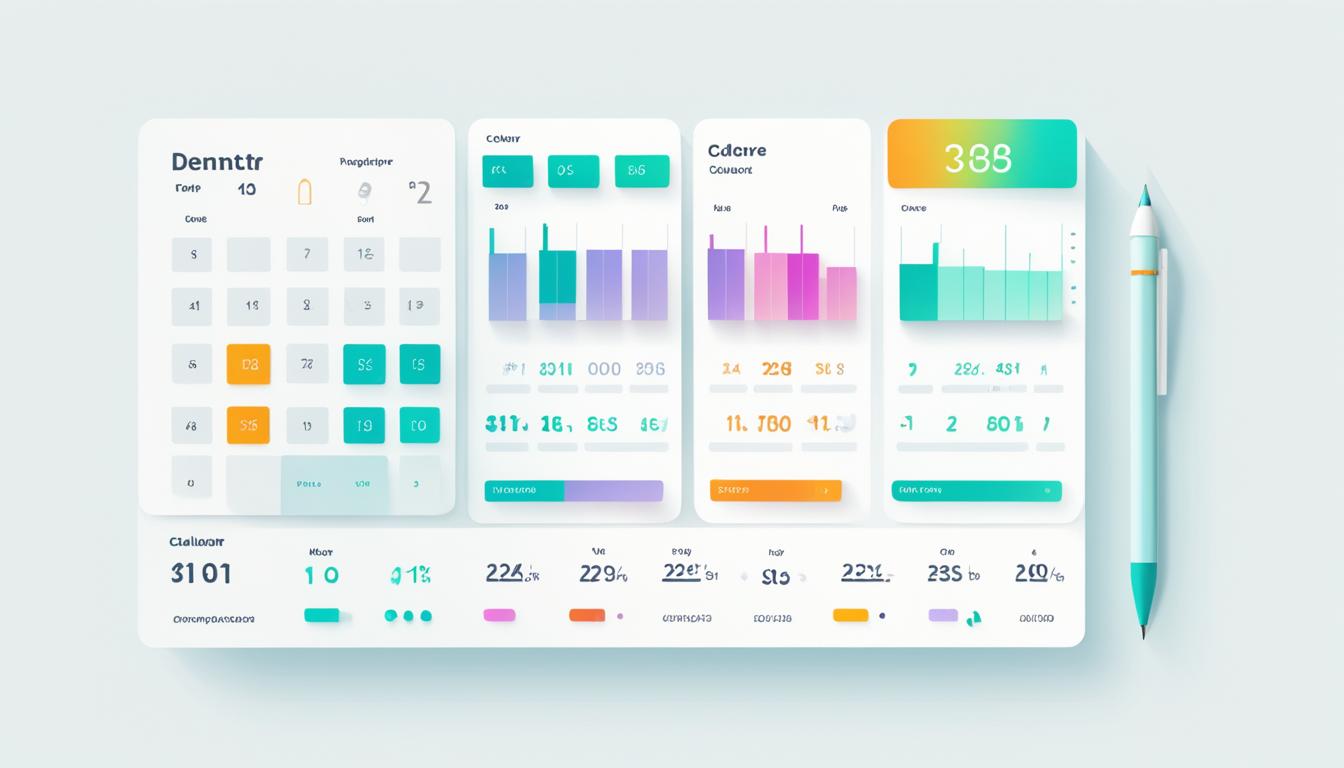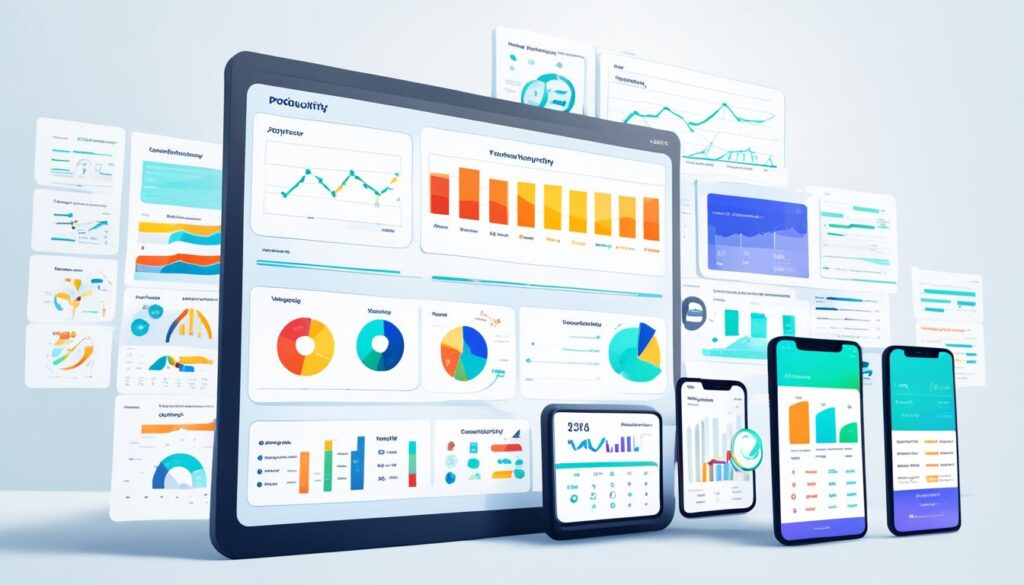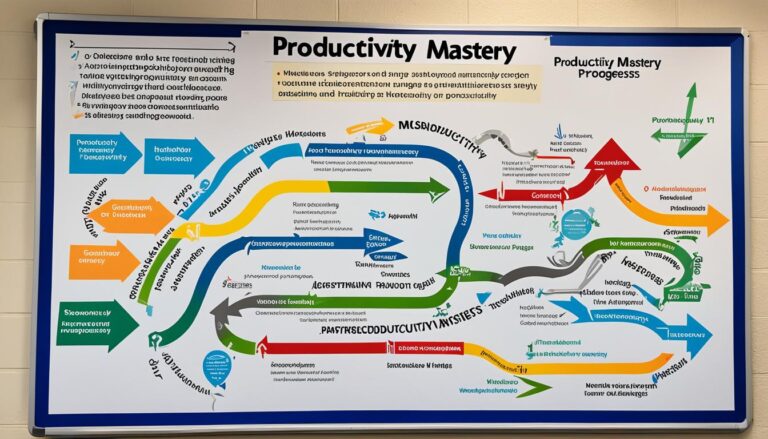Boost Efficiency with a Productivity Calculator

Are you tired of feeling overwhelmed by your workload? Do you want to maximize your productivity and achieve better results? It’s time to discover the power of a productivity calculator. This incredible tool can revolutionize your approach to work by helping you manage your time effectively, track your efficiency, and make data-informed decisions. But how does it work? What are the key benefits of using a productivity calculator? Let’s dive in and find out.
Key Takeaways:
- A productivity calculator is a time management tool that tracks and measures your efficiency in completing tasks.
- It helps you identify areas for improvement, set goals, and make data-informed decisions.
- With a productivity calculator, you can optimize your workflow and achieve better results in less time.
- There are various productivity calculators available, such as Rescue Time, Visual Paradigm, and Omni Calculator.
- Measuring your productivity is essential for enhancing efficiency and improving outcomes.
What is Labor Productivity?
Labor productivity is a key metric used to assess the efficiency and effectiveness of a business. It measures the amount of output, in terms of goods and services, that is produced per unit of labor. Specifically, labor productivity quantifies the level of output per worker or per labor hour.
Businesses use labor productivity as a vital tool for evaluating economic growth, comparing performance against industry benchmarks, and identifying areas for improvement. By calculating labor productivity, companies can gain insights into the efficiency and quality of their human capital, enabling them to make informed business planning decisions.
The formula for calculating labor productivity is simple. It involves dividing the revenue generated by the number of employees or the total number of labor hours worked.
When assessing labor productivity, it is important to consider both quantity and quality of output. While output per worker provides a measure of efficiency, it is equally important to ensure that the output is of high quality to drive overall business growth.
The Formula for Calculating Labor Productivity:
| Formula | Explanation |
|---|---|
| Labor Productivity | Revenue/Number of Employees or Labor Hours |
Why Labor Productivity Matters for Business Planning and Economic Growth
Labor productivity plays a crucial role in business planning and economic growth. By measuring and improving labor productivity, businesses can:
- Optimize resource allocation and workforce management
- Identify potential areas for process improvement to drive efficiency
- Compare performance against industry competitors and benchmarks
- Make data-driven decisions to enhance overall business performance
Ultimately, labor productivity serves as an indicator of a company’s ability to maximize output while utilizing the available labor resources effectively. By focusing on improving labor productivity, businesses can achieve sustainable economic growth and stay competitive in their respective industries.
How to Use a Productivity Calculator
Using a productivity calculator is easy. All you need is the revenue generated from goods or services produced within a given time period or by a specific number of employees. You can input either the number of employees or the total number of working hours to determine productivity per hour and per employee.
Let’s take an example to illustrate how it works. Suppose your business generated a revenue of $10,000 in a month and you have 50 employees. To calculate the productivity per employee, you can divide the revenue by the number of employees. So, the productivity per employee would be $200.
Similarly, if you want to determine the productivity per hour, you can divide the revenue by the total number of working hours. Let’s say your employees worked a total of 400 hours in a month. The productivity per hour would be $25.
The productivity calculator provides you with valuable insights into your business’s efficiency and allows you to make data-informed decisions. By tracking productivity trends over time, you can identify areas for improvement and optimize your operations.
Reverse Calculation
The productivity calculator can also work in reverse. This means that you can input desired results, such as a target revenue or number of employees, and calculate the required revenue, employees, or hours to achieve those goals.
For example, let’s say you want to achieve a revenue of $20,000 in a month. By inputting this target revenue into the productivity calculator and providing the productivity per employee, the calculator can determine the number of employees needed to reach the desired revenue.
Additionally, if you have a specific number of employees available, you can input this information along with the desired revenue to calculate the required productivity per employee or per hour.
Using a productivity calculator simplifies the process of tracking and analyzing productivity, enabling you to make informed decisions and drive your business towards greater efficiency and success.

Examples of Productivity Calculation
To better understand how to calculate productivity, let’s consider a few examples. These examples showcase how productivity can be measured in different scenarios, providing valuable insights for businesses to enhance their efficiency.
Example 1: Small House Cleaning Business
Imagine a small house cleaning business with two employees working 8 hours and generating $1200 in revenue. By using the productivity calculation formula, we can determine the productivity per person and per hour:
| Metrics | Calculation | Result |
|---|---|---|
| Revenue | $1200 | |
| Number of Employees | 2 | |
| Number of Working Hours | 8 | |
| Productivity per Person | Revenue / Number of Employees | $600 |
| Productivity per Hour | Revenue / Number of Working Hours | $150 |
From this calculation, we can conclude that each employee contributes a productivity value of $600, while the productivity achieved per hour of work is $150.
Example 2: Construction Employee Comparison
Let’s now compare the productivity of two construction employees, Mark and Rob, based on their monthly revenue and hours worked:
| Employee | Monthly Revenue | Hours Worked | Productivity per Hour |
|---|---|---|---|
| Mark | $3000 | 39 | $77 |
| Rob | $4500 | 79 | $57 |
Based on the above data, Mark’s productivity per hour is $77, while Rob’s productivity per hour is $57.
These examples demonstrate how productivity can be calculated using revenue, number of employees, and number of working hours. By measuring and analyzing productivity, businesses can make informed decisions to enhance efficiency and drive economic growth.

Three Productivity Calculators to Boost Efficiency
When it comes to improving efficiency, productivity calculators can be effective tools for both individuals and businesses. These calculators help track and measure productivity, leading to enhanced performance and optimal outcomes. Here are three highly recommended productivity calculators:
1. Rescue Time
Rescue Time is a powerful productivity calculator that tracks computer usage and provides detailed reports. It monitors the time you spend on various applications and websites, allowing you to identify time-wasting activities and prioritize tasks. With Rescue Time, you can gain valuable insights into your work habits and make informed decisions to improve efficiency and focus.
2. Visual Paradigm
Visual Paradigm is an online calculator specifically designed to simplify productivity calculations. With an intuitive interface, it allows you to input relevant values such as revenue, number of employees, or working hours. Based on these inputs, Visual Paradigm calculates and presents productivity metrics, providing you with valuable information to optimize resource allocation and enhance overall efficiency.
3. Omni Calculator
Omni Calculator takes productivity calculations to a whole new level by considering additional factors that impact efficiency. In addition to measuring productivity, it incorporates variables such as sleep deprivation and workplace motivation. By factoring in these elements, Omni Calculator aims to help individuals achieve a better work-life balance, prevent burnout, and foster sustained productivity.

These three productivity calculators, Rescue Time, Visual Paradigm, and Omni Calculator, offer unique features and functionalities tailored to different productivity needs. By integrating these tools into your workflow, you can not only measure productivity but also identify areas for improvement and take actionable steps towards enhanced efficiency.
| Productivity Calculator | Key Features |
|---|---|
| Rescue Time | Tracks computer usage, detailed reports, time management insights |
| Visual Paradigm | Simplifies productivity calculations, intuitive interface, resource optimization |
| Omni Calculator | Calculates productivity considering sleep deprivation and workplace motivation |
The Importance of Measuring Productivity
Measuring productivity is essential for individuals and businesses alike. It not only allows you to track your progress but also promotes responsibility and drives improved results. By setting clear goals and regularly measuring productivity, you gain valuable insights into your performance and identify areas for improvement. Additionally, measuring productivity over different periods enables you to analyze the impact of various factors and determine which ones are most influential in driving your success.
When measuring productivity, it’s important to focus on both quantity and quality. While quantity reflects the output and efficiency of your work, quality ensures that you are achieving your overall goals effectively. By taking a holistic approach, you can optimize your processes, enhance your performance, and reach new levels of success.
Setting goals and measuring productivity go hand in hand. By establishing specific targets, you create a sense of purpose and direction. Measuring productivity against these goals allows you to gauge your progress and make data-informed decisions that drive you closer to your desired outcomes.
Analyzing business processes is another critical aspect of measuring productivity. It enables you to identify bottlenecks, streamline operations, and maximize efficiency. By evaluating each step of your workflow, you can uncover areas where improvements can be made, leading to greater productivity and success.
Benefits of Measuring Productivity:
- Promotes responsibility and accountability
- Drives improved results
- Allows for setting clear goals
- Identifies areas for improvement
- Enables data-informed decision-making
- Analyzes the impact of various factors
- Optimizes processes and enhances performance
- Streamlines business operations
- Maximizes efficiency
Measuring productivity is more than just tracking numbers. It empowers you to take control of your success and continuously strive for improvement. By incorporating responsible measurement practices, setting goals, and analyzing your business processes, you can unlock your true potential and achieve remarkable outcomes.

| Factors to Measure | Methods of Measurement |
|---|---|
| Individual employee productivity | Number of tasks completed per hour, revenue generated per employee, customer satisfaction ratings |
| Team productivity | Number of projects completed, revenue generated, team efficiency ratings |
| Process efficiency | Time taken to complete a task, number of steps required to achieve a desired outcome, error rates |
| Resource utilization | Time spent on non-productive activities, percentage of time spent engaged in revenue-generating tasks |
Conclusion
Boosting efficiency and achieving desired outcomes is crucial for individuals and businesses alike. One effective way to accomplish this is by using a productivity calculator. By measuring productivity, you can make data-informed decisions, set goals, and identify areas for improvement. Whether you choose to use labor productivity formulas or productivity calculators, the key is to focus on both quantity and quality.
Measuring productivity positively affects the outcome and leads to improved results. It allows you to analyze productivity levels and make necessary adjustments to optimize your workflow and enhance overall performance. By harnessing the power of productivity calculators, you can improve efficiency and drive success in your personal or professional endeavors.
So, don’t wait any longer. Start measuring your productivity today and take control of your outcomes. With the right tools and the determination to make improvements, you can maximize efficiency, achieve your goals, and unlock your true potential.






